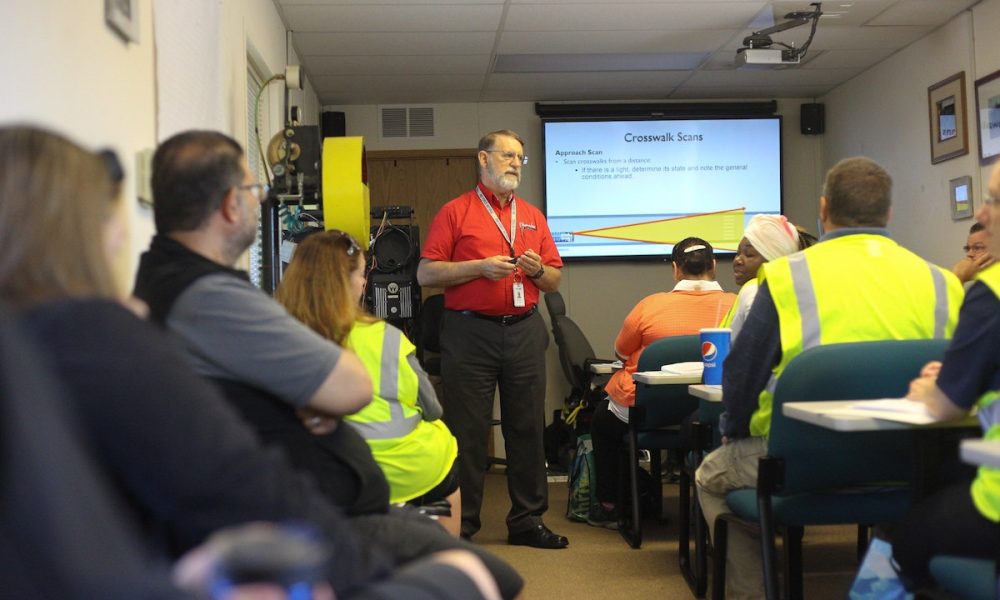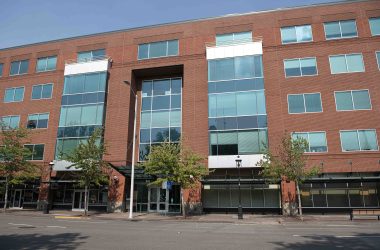 Don Rundle, training supervisor, talks with prospective drivers at a class Friday morning. State funds are fueling an expansion of its services in September and the transit agency has hired 30 new drivers since January. (Troy Brynelson/Salem Reporter)
Don Rundle, training supervisor, talks with prospective drivers at a class Friday morning. State funds are fueling an expansion of its services in September and the transit agency has hired 30 new drivers since January. (Troy Brynelson/Salem Reporter)
Standing in a portable, bus-sized classroom near Cherriots’ dispatch center, Don Rundle harped over a Powerpoint presentation: safety, safety, safety.
“Don’t let the pressure of the schedule force you into doing something stupid, like trying to beat the next light,” said Rundle, a training supervisor. “It’s not worthwhile.”
Rundle’s audience that Friday morning were 12 prospective bus drivers, facing schooling over the next several weeks in the hopes of joining Cherriots as the transit system readies to expand across Salem. Rundle often joked with the class, but safety underscored every word.
Scan your side mirrors every five to eight seconds, he told them. Stay far back from the car ahead because it’s not only safer but it avoids braking that might lurch passengers, he added. Snow is a four-letter word.
“I really appreciate the way you guys take notes,” he said, a quip to break up a quiet moment.
Keep local news going – subscribe to Salem Reporter.
The scene has become a common one in recent weeks, as the transit agency has been on a hiring spree thanks to a recent infusion of state dollars.
A bill lawmakers passed two years ago to raise about $5.3 billion for transportation projects statewide is starting to deliver its first funds for transit. The state forecasts Cherriots to get $16.5 million over the next two years, with more to follow.
The transit agency has hired 30 new bus drivers since January in part to revive its long-awaited Saturday service. After cutting the service for budgetary reasons in 2009, agency officials said many residents are ready for the service to return in September.
“Every time we put a (newsletter) out, it was always ‘OK, but what about Saturday service?’” said spokeswoman Patricia Feeny in a recent interview.
Cherriots now employs 123 full-time bus drivers, agency officials said. In 2018, the transit agency had nearly 3 million boardings on its buses.
Starting Sept. 3, most of Cherriots’ routes will run later into the evening on weekdays, offering trips as late as 11 p.m. Then, on Sept. 7, buses on 15 routes will start operating on Saturdays, though not as frequently as the weekday.
The new service is a “milestone a decade in the making,” said Ian Davidson, one of the agency’s directors.
“I’m a little biased but I think this absolutely huge for the community,” he said. “Given the size of our city and being a state capital, it’s been a little embarrassing losing Saturday service.”
Davidson officially became a director on the agency’s board July 1, after his appointment by Gov. Kate Brown. He also works as an analyst for Oregon’s Criminal Justice Commission. He said he said buses going kaput every weekend hurt many.
“Just from a pure jobs perspective, the inability of employees getting to work if they need to work on weekends, is mind boggling,” he said. “Throw in everything else people use public transit for. I’d love to bus down to the Saturday market.”
State dollars are helping staff up at Cherriots, said Traffic Manager Mark Poulson, everything from office assistants to supervisors. The agency is also buying more buses, and training drivers to fill those open seats.
 Hector Chavez, 42, inspects a Cherriots bus in between shifts. Chavez is among 30 new drivers Cherriots hired since January as it gears up for an expansion of routes, funded in part by state dollars. (Troy Brynelson/Salem Reporter)
Hector Chavez, 42, inspects a Cherriots bus in between shifts. Chavez is among 30 new drivers Cherriots hired since January as it gears up for an expansion of routes, funded in part by state dollars. (Troy Brynelson/Salem Reporter)
Poulson said most interviews with candidates revolve around temperament. Driving skills are essential to a professional bus driver, but disarray can appear inside the bus as quickly as it can on the road.
“We’d rather get someone who is a vetted, customer service professional. We see people on their absolute best and absolute worst days,” he said. “Anything that can happen in a football stadium happens in a bus.”
Nothing too difficult has occurred yet under the watch of Hector Chavez, a 42-year-old Salem resident who just completed his seven-week training. He now starts a probationary period for six months.
The hardest part of the training, Chavez said, was memorizing everything needing inspection before every shift. There are 41 functions to check before taking the bus out from the brakes to the oil to the electronic signs.
Before he spotted a sign on a bus advertising the bus driver job, Chavez, 42, worked more than a decade in restaurants. He also had stints working as a care worker for the elderly, he said. He said long hours and moody clients aren’t new to him — but the job still intimidated him.
“It’s a 40-foot vehicle,” he said. “It was like ‘Oh my goodness, what am I getting into?’”
Chavez said he was mainly allured by the job’s benefits and retirement plans. He grew up in the rural Mexican state of Guerrero before arriving in Oregon in 1996. With three sons in private school, he and his wife both worked two jobs.
“I’m not a rich person, but the best thing I can give you is an education,” he said.
Starting his bus-driving career, Chavez is poised to make $21.33 per hour. By Dec. 1, the end of his probationary period, he will join the union and start making $22.21 per hour.
Drivers can receive merit raises every year based on performance, Poulson said.
Have a tip? Contact reporter Troy Brynelson at 503-575-9930, [email protected] or @TroyWB.
Correction: A previous version of this article incorrectly misstated Davidson and Chavez’s birthplaces. They grew up in Seattle and the Mexican state of Guerrero, respectively.









